Essential Ingredients for Agency Marketing in 2015

By: Peter van Aartrijk
The key word industry consultants and independent agents use to predict success for customer and prospect marketing in 2015? Balance.
A thoughtful strategy will incorporate both online and traditional methods into the mix—and that could mean a shake-up in next year’s marketing budget.
The mounting challenge for agents continues to be today’s evolving insurance consumer, who has more control over the referral process to potentially connect with an agent. Consumers are not passively waiting in someone’s sales funnel. They research options and move quickly. They still value relationships, but they choose high-quality providers they deem trustworthy and efficient—and those providers can be anywhere.
That means agents must get creative and proactive to reach the point of actual sale. Here’s how the smart ones are making the shift and spending marketing dollars to get there.
Brand Strategy
Successful agencies tie customer and prospect marketing to a grand plan—specifically, a brand strategy.
“Agencies absolutely need a strategy, and quickly, because they’re in danger of losing out on the millennial market,” says Terry Golesworthy, president of The Customer Respect Group, a digital marketing consultancy. “An agency that has not been refreshing its customer base is not as valuable as the principal might think when the time comes to sell and retire.”
But the issue is bigger than social and digital. “When agents look at a social plan, it becomes tactical: ‘We need a Facebook page, so let’s get an intern,’” Golesworthy says. “They’ll paste a picture of a flag on the Fourth of July or forward a photo from a carrier. That doesn’t really work.
It costs money because you’re wasting time. There’s no investment, no plan,
no strategy.”
Instead, agents should ask: Where is our agency in the next five years? What part of our business are we trying to grow? Who do we need to reach?
Marty Agather, senior vice president at TrustedChoice.com, worked for 10 years at a family agency in Chicago before transitioning to the insurance technology industry. He says it’s not effective to spend money today on vague, feel-good, appeal-to-everybody marketing.
“The first thing to get out of your head is, ‘We are a generalist that does everything for everybody,’ ” Agather says. “That message carries no weight with today’s consumer. New consumers are doing research to find out whether you specifically can solve their problems. So you need to create your agency brand and your personal brand around things that are tangible. You really have to tell somebody exactly why you are the expert who can help.”
The plan should not rely on one tactic. Instead, consider a balanced approach to marketing, advises technology consultant Steve Anderson: “It’s a number of things that work together to create an Internet presence so the agency is visible to the online consumer. It’s an art and a science.”
Agency prospects—commercial as well as personal lines—are self-marketing, Anderson says. “They’re in multiple places—on a website, looking at LinkedIn profiles,” he explains. “That’s where content marketing comes from. Agencies need to demonstrate their expertise by having information out there—articles, audio, video.”
Online Options
Anderson urges agents to use automated marketing to manage prospect and customer campaigns. “Most agencies don’t know how to market in the true definition of the word,” he says. “They’ve done the networking, the chamber and the golf. That certainly has worked well, and still does, in some cases.” But digital marketing fixes what he calls follow-up failure.
“Agents just don’t follow up with prospective clients,” Anderson says. “This is where you can create a multiple-touch process that automatically is done for you. It doesn’t mean it’s exclusively electronic, but the producer or staff doesn’t have to remember what to do next. It’s predefined. It’s a more disciplined approach to marketing.”
Anderson recommends agents investigate advertising and promoted posts on Facebook and LinkedIn. “I can target on Facebook, by ZIP code or by town, an individual who owns a home valued between $300,000 and $600,000 with a homeowners policy that’s up for renewal,” he says. “Many agents have no clue of that capability.”
Golesworthy agrees. “In the old days, there was no choice of how to buy insurance. People now have a choice, and they’re choosing ease of doing business over the value of a relationship with an agent,” he says. “They want a relationship, but they’re choosing simple.”
Lynn Mathis, president and chief operating officer of Williams, Turner & Mathis, Inc. in Atlanta, Ga., uses a digital marketing system for various monthly email blasts to her agency’s clients and prospects. Sometimes it’s a birthday or holiday greeting, which might be considered a small message, Mathis acknowledges. “But it’s surprising how often people respond with something that’s been on their mind for a while,” she says. “Our outreach provides an opportunity to converse.”
The Classics
Homegrown advertising concepts are working well at Cherry Creek Insurance Group in Greenwood Village, Colorado, says CEO Brook Mahoney.
The agency invests about 2% of revenue in marketing, and a fair amount of that spend goes to affinity groups, chamber of commerce programs and charity events. That trend will continue, Mahoney says, with less spending on traditional ads in industry publications.
What about the digital shift? “Advertising is in transition, but we’re not 100% committed to shifting all dollars from printed ads,” Mahoney said. “Digital messages come and go quickly as opposed to journals that people read and study. We have done digital communications, but we’re not convinced they have staying power. We get more bang for the buck by reinvesting in affinity groups. Having a presence there is important. Sponsoring is important. Contributing is important.”
Mahoney says commercial prospects aren’t highly engaged on social media platforms, so his agency doesn’t plan to invest there—its book of business is 80% commercial lines. “That level of engagement will change with time, but right now, social media does not have the impact we need to see for the effort it takes to maintain,” said he explains.
Jan Wood, personal lines manager at Watson Insurance in Gastonia, North Carolina, says referrals drive the most sales and highest close ratios. Each quarter, the agency conducts drawings for TVs or other electronics. When customers refer others, they get a name in a drawing. If they allow Watson staff to make a phone call with a prospect, they get two entries in the drawing. Watson does not have to write insurance for the prospect for the client to be entered in the drawing. “The first time we ran this promotion, we got 700% return on our investment,” Wood says. “That’s amazing.”
Dollars and Sense
Shirley Lukens, a principal at Reagan Consulting, which has collaborated on the Big “I” Best Practices Study for 20 years, says leading agencies have steadily invested 1–2% of annual net revenues in customer and prospect marketing. That trend held even in down economies. The most profitable among the 200+ Best Practices firms tend to spend a little less. Firms growing the most spend a little more.
While the percentages haven’t changed, the leaders in growth and profitability in the Best Practices group are now investing differently, Lukens says. Yellow Pages ads were expensive and reached a general audience. Social media, websites and email are less expensive and more effective, as they reach specific audiences, she says.
Michael Jans, founder and president of agency consulting firm Agency Revolution, urges agents to look beyond the spending benchmarks provided by Best Practices. While the typical investment numbers are a starting point, “one best practice is to violate best practices—to test, to experiment, to adopt new technologies, to break the mold,” he says. “This industry is a sitting duck for disruption. If we don’t get disrupted from the inside, well get disrupted from the outside.”
Claudia McClain, president of McClain Insurance Services in Everett, Washington, a 100% personal lines firm, spends 5–7% of revenue on marketing programs. “We are a retention business,” she says. “We have 96% retention, and we keep clients for an average of 15 years. If it costs me 150% of first-year commission to acquire a piece of business I’m going to retain for 15 years, that’s a good investment. My goal is one-to-one on spending and first-year return. But as long as we can make money long-term, I’m in.”
Getting It Done
Agencies can struggle with how to manage today’s marketing requirements, including whether to administer the plan in-house or to outsource. Golesworthy says agents need to stock up on professional digital marketing talent—an expensive but worthwhile strategy. “Agents have to invest in their own future,” he says.
Many agencies are transitioning from in-house efforts, still employing a mix of resources. At Mahoney’s firm, management and tech staff put together ad copy, and an outside firm develops and places the ads. The agency is considering adding a staff position for agency marketing because current procedures are time-consuming and pull people away from their core responsibilities.
“We are in a time of change. It’s scary for everybody,” Agather says. “But the agents who explore and replicate what’s successful will find themselves in a completely different space five to 10 years from now than those who grab their underwriting manual tightly and say, ‘I only know how to do things this way.’ ”
Peter van Aartrijk is an IA contributor. Defining Digital MarketingIt’s important to understand the three main components of digital marketing, advises Michael Jans, president of online consulting firm Agency Revolution: Website. Your online office should have the same valuable information consumers would find at a physical location: quote request forms, contact information, branding statements and more. Social media marketing. This virtually free series of platforms should engage customers, personalize relationships and deliver value. Don’t miss out on these conversations—they’re today’s cocktail party. Marketing automation. This combination of services often ties in to the agency management system to automate all of the firm’s marketing, including email, video email, drop-down boxes and landing pages with video. It also includes letters and postcards that go out in sequence. The marketing can drive prospects to social sites. An agency with 10,000 clients could deliver 250,000 value-laden communications throughout a year, considering birthdays and other lifecycle events, renewals, claims, open quotes, seasonal events, new customers and cross-sell opportunities. —P.V. |










